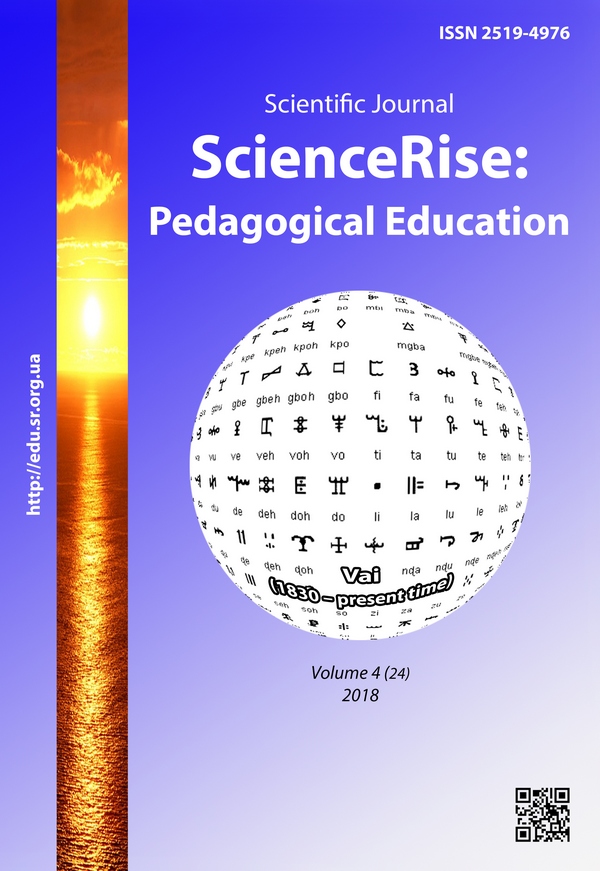Modern trends of art post-graduate pedagogical education
DOI:
https://doi.org/10.15587/2519-4984.2018.132657Keywords:
art post-graduate pedagogical education, qualification improvement, special course, creative potential of a professorAbstract
The article is devoted to considering modern tendencies of art post-graduate pedagogical education. There are elucidated views of native scientists about tendencies of art education development under conditions of post-graduate pedagogical education. There are noted three main components that provide andragonization of content, forms and methods of teaching in the system of post-graduate pedagogical education, among which: problem character of content of post-graduate pedagogical teaching, use of situation character of learning and procedural norms of its existence, dialogue character of its content. The native experience of organization of art post-graduate pedagogical education is described. There are elucidated the ways of mastering innovative pedagogical and art technologies at courses of qualification improvement for professors of art disciplines. There are described the author special courses, directed on spreading ideas of the advanced pedagogical experience. Problems of the development of pedagogical creativity and creative potential of a professor of art disciplines are indicated. Special features of the training course are described; construction, advantages of teaching and training components are elucidated. There are determined the main problems in organizing courses of qualification improvement for art professors. There is presented the experience of organizing problem, author, thematic courses, directed on developing the creative potential of professors of art disciplines. There is presented the experience of the special course, directed on developing the creative potential of a professor of art disciplines. The structure of integrating training activities is described. The attention is accented on the content component of the special course on developing the creative potential of professors of art disciplines. There are elucidated problems of motivation to creative kinds of activity, assessing-reflecting component. There are indicated problems of individualization of teaching, choice for an individual trajectory of creative learning. There is elucidated the practical directionality of teaching professors of art disciplines in the training course on developing the creative potential, types of pedagogical practice organization. There are elucidated problems of creation of the scientific-methodological and visual support of the educational process in post-graduate pedagogical education. The attention is accented on the content filling of thematic, problem courses for improving the quality of teaching professors. There are determined the prospects of development of course training and main directions of solving modern problems in art post-graduate pedagogical education
References
- Padalka, H. M. (2008). Pedahohika mystetstva (Teoriia i metodyka vykladannia mystetskykh dystsyplin). Kyiv: Osvita Ukraina, 274.
- Rudnytska, O. P. (2002). Pedahohika: zahalna ta mystetska. Kyiv, 270.
- Kozyr, A. V. (2016). Osnovni tendentsii rozvytku mystetskoi osvity na suchasnomu etapi. Profesionalizm pedahoha: teoretychni i metodychni aspekty, 3, 25–37.
- Kuznetsova, V. M., Shevernytska, N. M. (2017). Suchasni tendentsii mystetskoi osvity. Mystetska osvita. Visnyk KhDADM, 3, 15–19.
- Otych, O. M.; Ziaziun, I. A. (Ed.) (2009). Mystetstvo u systemi rozvytku tvorchoi indyvidualnosti maibutnoho pedahoha profesiinoho navchannia: teoretychnyi i metodychnyi aspekty. Chernivtsi: Zelena Bukovyna, 752.
- Oliinyk, V. V. (2012). Sohodennia ta perspektyvy rozvytku pisliadyplomnoi pedahohichnoi osvity. Postmetodyka, 4 (107), 2–6.
- Sushchenko, T. I. (2007). Kontseptsiia rozvytku pisliadyplomnoi pedahohichnoi osvity. Pisliadyplomna osvita v Ukraini, 1, 23–27.
- Ustynova, N. V. (2006). Rozvytok tvorchoho potentsialu vchytelia u systemi pisliadyplomnoi osvity. Kyiv, 24.
- Huzii, N. V. (Ed.) (2003). Tvorcha osobystist uchytelia: problemy teorii i praktyky. Kyiv: NPU, 10, 331.
- Shcholokova, O. P. (2004). Khudozhnie myslennia v umovakh pedahohichnoi diialnosti vchytelia mystetstva. Teoriia i metodyka mystetskoi osvity. Kyiv: NPU, 5, 35–39.
- Sysoieva, S. O. (2006). Osnovy pedahohichnoi tvorchosti. Kyiv: Milenium, 344.
- Konevshchynska, O. E. (2009). Formuvannia media-kultury maibutnikh uchyteliv muzyky. Kyiv, 21.
- Selevko, G. (2004). Kompetentnosti i ikh klassifikatsiya: (Opredelenie ponyatiy). Narodnoe obrazovanie, 4, 138–143.
- Myroshnyk, S. I. (2009). Suchasni pidkhody do navchannia pedahohiv-slovesnykiv yak umova rozvytku kompetentnosti i tvorchosti uchniv Narodna osvita, 2 (8). Available at: https://www.narodnaosvita.kiev.ua/Narodna_osvita/vupysku/8/statti/3miroshnik/miroshnik.htm
- Nikolenko, L. (2007). Modernizatsii pisliadyplomnoi pedahohichnoi osvity v konteksti osobystisno oriientovanoho pidkhodu. Pisliadyplomna osvita v Ukraini, 2, 38–41.
- Khutorskoy, A. V. (2003). Klyuchevye kompetentsii kak komponent lichnostno-orientirovannoy paradigmy obrazovaniya. Narodnoe obrazovanie, 2, 58–64.
- Naboka, L. Ia. (2001). Kulturolohichnyi pidkhid do rozvytku osobystosti pedahoha u systemi pisliadyplomnoi osvity. Pisliadyplomna osvita v Ukraini, 1, 57–60.
- Maksymenko, S. (Ed.) (2008). Tekhnolohiia treninhu. Kyiv: Slovo, 112.
Downloads
Published
How to Cite
Issue
Section
License
Copyright (c) 2018 Anastasia Lavrinets

This work is licensed under a Creative Commons Attribution 4.0 International License.
Our journal abides by the Creative Commons CC BY copyright rights and permissions for open access journals.
Authors, who are published in this journal, agree to the following conditions:
1. The authors reserve the right to authorship of the work and pass the first publication right of this work to the journal under the terms of a Creative Commons CC BY, which allows others to freely distribute the published research with the obligatory reference to the authors of the original work and the first publication of the work in this journal.
2. The authors have the right to conclude separate supplement agreements that relate to non-exclusive work distribution in the form in which it has been published by the journal (for example, to upload the work to the online storage of the journal or publish it as part of a monograph), provided that the reference to the first publication of the work in this journal is included.








